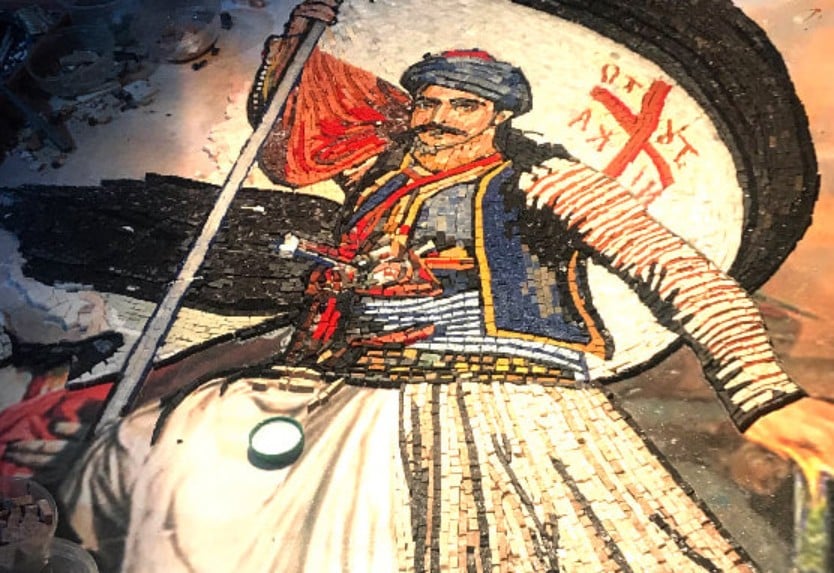
Greek mosaic artist Grigoris Kalagias creates stunning artworks while keeping his country’s history alive and accessible for this generation and the ones to come.
Kalagias has spent the past two years working on an incredibly intricate and important project which aims to honor the bicentennial of the Greek Revolution by reinterpreting famous artworks which depict the conflict in mosaic form.
Greek mosaic artist Kalagias
Kalagias, who is one of the leading figures in the art of mosaics, has created jaw-dropping art pieces for a number of clients, including churches across Greece and private clients on islands across the Aegean and Ionian Seas.
In an exclusive interview with Greek Reporter, Kalagias delved into how he got into mosaics as an adult following a lifetime of being involved in art.
“When I was child I loved drawing, and as I grew older I eventually got into mosaics. This might have been because there were some to be found in the area I lived in,” reminisced Kalagias.
Mosaics can be found all around Greece, and are particularly popular forms of decor in churches and hotels. This ancient style of art is everywhere and integrated into people’s everyday lives, truly helping cities, towns and villages come alive.
“You only do mosaics if you love them. It is definitely an art defined by patience,” he explains.
“At the beginning I wanted to replicate artworks by Byzantine artists. I put in 16-hour days for four months to recreate a piece and I wouldn’t sell it for the world,” says Kalagias of his dedication to his craft and the importance of loving what you do, particularly if it is something as painstakingly detailed as the art of mosaics.
Kalagias places an extreme importance on the materials that he uses to make his masterpieces, opting to always use natural materials for them. Although these days there are many artificially-colored mosaic pieces which can allow for a wider color palette, Kalagias searches for pebbles, stones and marble which can express the same point of view without looking artificial.
A video of Kalagias’ process is shown below.
A stunning art project devoted to 1821
The bicentennial of the Greek Independence is celebrated all this year, of course, and Greeks have banded together to commemorate this important milestone in a multitude of ways.
One of these is the “Bicentennial Initiative 1821-2021,” a massive project which includes museum exhibitions, art projects, and events all centered around the Greek War of Independence.
This initiative has been funded by a long list of institutions and donors, with the continued support and involvement of the Greek Ministry of Culture and Sports.

“Two years ago, I said to one of my friends: ‘shouldn’t we do something, some sort of exhibit, to celebrate the bicentennial?'” Kalagias explains, recounting how his involvement in the Bicentennial Initiative came to be.
Eventually, he settled on the idea of reinterpreting the art medium of ten famous paintings which depict scenes from the Greek War of Independence. Kalagias decided to dedicate two years to creating mosaics which celebrate Greece’s history and the individuals who fought to get the country where it is today.
He has reimagined extremely impactful pieces such as “Nikos Mitropoulos hoists the flag at Salona,” by Louis Dupré, which depicts the Battle of Amfissa.
Kalagias spoke about the piece he is currently working on, which is named “After the Destruction of Psara,” by Nikolaos Gyzis.
“Now I am starting ‘After the Destruction of Psarra’, and we will also do a mosaic seminar. And it will be so different to other art spaces because here the idea will be ‘please touch the art’ which is entirely opposite of the normal rules of engagement in these spaces,” Kalagias elaborated.
An enduring Greek art form
Mosaics have been the pride and joy of Greek art for centuries.
Although some may consider them archaic, they continue as a thriving art form to this day, both in Greece and abroad.
“There are a lot of people that are involved in mosaic-making; however in art schools in Greece there isn’t a major or concentration offered in mosaics. Most people are self-taught.
“And that means they have their own individual ability and knowledge to pass on. You may have knowledge on how mosaics used to work and be created but today’s necessities are different,” said the Greek mosaic artist about the art form.
He also touched on the history of mosaics, and how they came to be such an influential style of art across the world.
“The art of mosaic-making started because people needed to make floorings in the Cycladic Islands.
“The first mosaics, from what I have understood through my research, were made in Greece,” Kalagias said.
How fitting it is to use a Greek art form to celebrate Greece itself!
See all the latest news from Greece and the world at Greekreporter.com. Contact our newsroom to report an update or send your story, photos and videos. Follow GR on Google News and subscribe here to our daily email!



